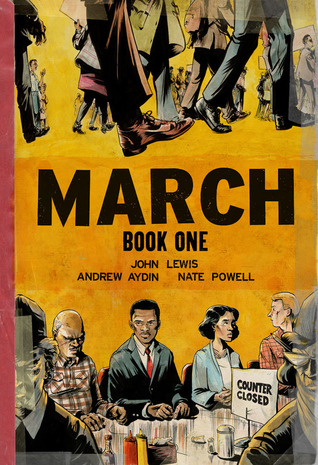Description: March is a vivid first-hand account of John Lewis’ lifelong struggle for civil and human rights, meditating in the modern age on the distance traveled since the days of Jim Crow and segregation. Rooted in Lewis’ personal story, it also reflects on the highs and lows of the broader civil rights movement.
Book One spans John Lewis’ youth in rural Alabama, his life-changing meeting with Martin Luther King, Jr., the birth of the Nashville Student Movement, and their battle to tear down segregation through nonviolent lunch counter sit-ins, building to a stunning climax on the steps of City Hall.
Many years ago, John Lewis and other student activists drew inspiration from the 1950s comic book "Martin Luther King and the Montgomery Story." Now, his own comics bring those days to life for a new audience, testifying to a movement whose echoes will be heard for generations.
Review: March: Book 1 is told in the backdrop of Barack Obama's presidential inauguration, a monumental moment in U. S. History and a well suited time to reflect upon the Civil Rights Movement. In the first of three volumes, we get a quick introduction into the childhood of Senator Lewis and how he got involved in the non-violent activism. This volume is centered on the desegregation of lunchroom counters in the south. Lewis recounts his involvement in the peaceful protest from its inception to how the protestors prepared themselves for any and all types of reactions from the white southerners by having the protestors role playing and acting out verbal and physical abuse they might foresee and finally to the actual protest. While this volume doesn't add much to what I already knew about the protest from my history classes, it is a startling how non-violence resistance worked especially in today's world where violence, and in many cases ultra-violence, is a knee jerk reaction. It makes us stop and think if non-violence can/will work once again.
The artwork is solid and makes the people in the story come alive. There were a few panels in which I couldn't read the text as characters seem to be mumbling or whispering things, which may have been intentional by the artist. Overall, I can definitely see March: Book 1 and the rest of this trilogy be used as part of the classroom curriculum and if it's not, it definitely should be. In my opinion there is a detachment when we read about history in textbooks. We get caught up in learning facts to pass a test and don't necessarily take the time to digest the information and really learn from it. It certainly does not have the sense of immediacy and significance when it is told by a person who lived through the actual real life events. I will definitely finish this important trilogy.
Curriculum Connection: Social Studies and English
Rating: 4 stars
Words of Caution: There is some strong violence in the graphic novel and the "n" word appears quite frequently. Recommended for Grades 9 and up.
If you like this book try: March: Book Two by John Lewis, Strange Fruit by Joel Christian Gill, The Silence of Our Friends by Mark Long













This sounds really interesting, probably not one I would pick up but still, I'm glad they do have these type of reads out there. Definitely makes it easier for some I'm sure than a normal history type read.
I read about this book recently and thought it sounded good so thank you for the reminder!